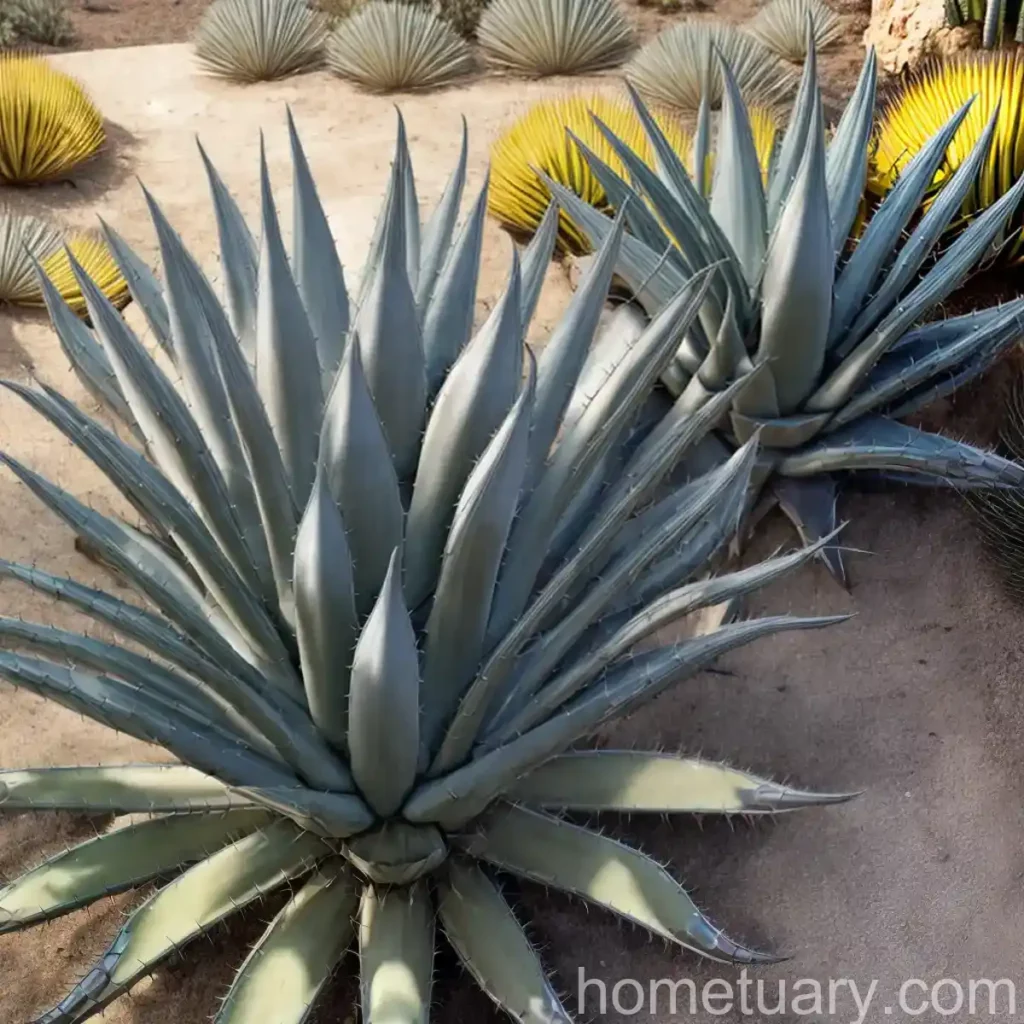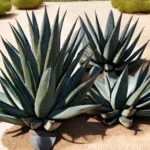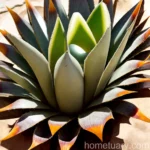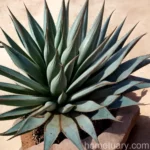The Century Plant (Agave havardiana)
In the world of succulents, the century plant (Agave havardiana) stands out as a striking and resilient specimen. This blog post will delve into the various aspects of the century plant, providing insights into its characteristics, care requirements, uses, and more. Whether you are a seasoned gardener or just starting out, you will find valuable information about this fascinating plant.
What is the Century Plant (Agave havardiana)?
The century plant, scientifically known as Agave havardiana, is a species of agave native to the Chihuahuan Desert, particularly found in the regions of New Mexico and Texas. Belonging to the Asparagaceae family, this perennial succulent is renowned for its striking appearance and its ability to thrive in arid and semi-arid environments.
Agave havardiana is characterized by its rosette-shaped form, with succulent, gray-green leaves that have prominent teeth along the margins. It blooms once in its lifetime, typically around 10 to 30 years of age, hence the common name “century plant.” The flowering stalk can reach impressive heights, often exceeding 10 feet, and is adorned with delightful yellow flowers.
The natural habitat of the century plant underscores its adaptability to extreme conditions, making it a quintessential example of a xerophytic plant – one that has evolved to survive in harsh, water-limited environments. This ability to thrive in dry climates, alongside its captivating aesthetics, has contributed to its popularity in landscaping and gardening.
Key Takeaways – Century Plant (Agave havardiana)
Before delving into the specifics of caring for the century plant, it’s essential to understand its key characteristics and attributes. Here are some key takeaways about Agave havardiana:
- Natural Habitat: Indigenous to the Chihuahuan Desert, the century plant is well-adapted to arid and semi-arid environments, thriving in sandy and rocky soils.
- Appearance: Its rosette shape and striking gray-green leaves, adorned with pronounced teeth along the margins, make it a visually captivating plant.
- Blooming: The century plant blooms once in its lifetime, typically after 10 to 30 years, producing a tall flowering stalk adorned with yellow flowers.
- Xerophytic Adaptation: Agave havardiana is a xerophyte, demonstrating adaptations that allow it to survive in water-limited environments.
Now that we have a foundational understanding of the century plant, let’s explore the various aspects of caring for this remarkable succulent.
Culture
The culture of the century plant encompasses a range of practices and considerations essential for its successful growth and development. From its water and sunlight requirements to the type of soil it thrives in, understanding its cultural needs is fundamental to fostering a healthy and flourishing specimen.
Uses
Before delving into the specific care requirements for the century plant, it’s important to appreciate its diverse uses. Here are some of the notable uses of Agave havardiana:
- Landscaping: The century plant is a popular choice in desert and xeriscape landscaping, adding a striking visual element to arid environments.
- Fiber Production: Historically, agaves have been used for the production of fiber for textiles and ropes, with some species, including Agave havardiana, contributing to this industry.
- Medicinal Purposes: Some traditional medicinal practices involve the use of agave extracts for various purposes, from wound healing to digestive remedies.
Understanding these uses provides a broader perspective on the significance of the century plant and its place in various cultural and industrial contexts.
Water
As a xerophyte, the century plant has low to moderate water needs, reflecting its adaptation to arid conditions. Understanding the water requirements of Agave havardiana is crucial for preventing overwatering, which can lead to root rot and other issues.
- Watering Frequency: During the growing season, which is typically spring and summer, water the century plant deeply but intermittently, allowing the soil to dry out between waterings.
- Winter Watering: In the winter months, reduce watering significantly to mimic the plant’s natural environment, where rainfall is scarce.
- Signs of Overwatering: Avoid overwatering, which can cause the leaves to become mushy and discolored, indicating potential root rot.
By adhering to these watering guidelines, you can ensure the health and vitality of your century plant while mimicking its natural habitat.
Sunlight
One of the defining features of the century plant is its love for sunlight. This succulent thrives in full sun, making it an ideal choice for gardens and landscapes with ample sunlight exposure.
- Sun Exposure: Position your Agave havardiana in a location that receives at least six hours of direct sunlight per day.
- Indoor Considerations: If grown indoors, place the plant near a south or west-facing window to provide adequate sunlight.
- Sun Stress: Under intense sunlight, the leaves of the century plant may develop a charming reddish tint, a natural response to maximize sunlight absorption and reduce water loss.
Understanding the sunlight preferences of the century plant is essential for ensuring its vigorous growth and vibrant appearance.
Fertilizer
While the century plant is renowned for its resilience and ability to thrive in nutrient-poor soils, occasional fertilization can support its growth, especially when cultivated in containers or in less fertile soils.
- Fertilization Frequency: Apply a balanced, low-nitrogen fertilizer to your Agave havardiana once a year in the spring to supplement the nutrient content of the soil.
- Dilution and Application: Ensure that the fertilizer is diluted to half or quarter strength to prevent excess salt buildup, which can be detrimental to the plant.
- Avoid Over-fertilization: Refrain from over-fertilizing, as agaves are adapted to nutrient-deficient environments and can be negatively impacted by excessive nutrients.
By incorporating appropriate fertilization practices, you can provide your century plant with the necessary nutrients for optimal growth while respecting its adaptation to low-nutrient conditions.
Soil
The soil requirements of the century plant are closely tied to its native habitat, reflecting its preference for well-draining, sandy, or rocky soils commonly found in desert regions.
- Well-Draining Soil: Plant Agave havardiana in well-draining soil to prevent waterlogged conditions, which can lead to root rot.
- Sandy or Rocky Substrate: Mimic the plant’s natural habitat by using a mixture of sand, gravel, and rocky substrate to ensure optimal drainage.
- Container Considerations: If growing the century plant in a container, choose a well-draining cactus mix or amend regular potting soil with sand and perlite to improve drainage.
Understanding and replicating the preferred soil conditions of the century plant is crucial for fostering a healthy root system and overall plant vitality.
Pruning
Pruning Agave havardiana is relatively minimal compared to other garden plants. The focus of pruning is primarily on the removal of dead or damaged leaves and the flower stalk after it has bloomed.
- Dead Leaf Removal: Trim off dead or withered leaves near the base of the plant to maintain its aesthetic appeal and prevent pest and disease issues.
- Flower Stalk Removal: Once the century plant has bloomed, the towering flower stalk can be removed to redirect the plant’s energy back into vegetative growth.
By implementing selective pruning as needed, you can ensure that your century plant maintains a tidy and healthy appearance while promoting its vigor.
Propagation
The propagation of the century plant can be achieved through offsets, also known as “pups,” which are young plants that emerge from the base of the parent plant.
- Offset Separation: Carefully remove offsets from the parent plant, ensuring that they have developed sufficient roots and a small rosette of leaves.
- Rooting Medium: Plant the offsets in a well-draining rooting medium, such as a cactus mix, and keep the soil lightly moist until roots are established.
- Established Plants: Once the offsets have developed a robust root system, they can be transplanted into individual containers or outdoor locations.
By propagating the century plant through offsets, you can expand your collection of these striking succulents and share them with fellow gardening enthusiasts.
Container Popularity
Agave havardiana’s popularity as a container plant stems from its striking appearance and adaptability to container culture.
- Outdoor Containers: The century plant can be featured as a focal point in outdoor container gardens, adding a dramatic and architectural element to the landscape.
- Indoor Containers: When grown indoors, Agave havardiana can thrive in containers, provided that it receives ample sunlight and is situated near a window with sufficient light exposure.
- Container Size: Choose a container that allows for ample root space, as agaves can develop extensive root systems, and ensure that it has drainage holes to prevent waterlogging.
Whether displayed outdoors or indoors, the century plant can thrive and make a bold statement in a container setting.
Common Diseases
While the century plant is relatively resistant to diseases, it can be susceptible to certain issues, particularly if its cultural requirements are not met.
- Root Rot: Overwatering or poorly drained soil can lead to root rot, characterized by mushy and discolored roots and base of the plant.
- Fungal Infections: Prolonged periods of moisture can create conditions favorable for fungal infections, leading to leaf spotting and browning.
Preventing these issues through proper cultural practices, especially concerning watering and soil conditions, is crucial for mitigating the risk of disease in Agave havardiana.
Disease Diagnosis
Diagnosing potential diseases in the century plant involves careful observation and assessment of its symptoms and environmental conditions.
- Visual Symptoms: Observe the foliage and base of the plant for signs of discoloration, browning, or mushiness, which may indicate diseases such as root rot or fungal infections.
- Soil Moisture: Evaluate the soil moisture to ensure that the plant is not experiencing prolonged periods of wetness, which can contribute to disease development.
- Cultural Practices: Reflect on your watering, soil, and sunlight practices to identify any deviations from the century plant’s preferred cultural conditions.
By actively monitoring the plant and its growing environment, you can swiftly identify and address potential disease issues to safeguard the health of your century plant.
Common Pests
While the century plant is relatively resilient against pests due to its tough, succulent leaves, it can still be susceptible to certain insects.
- Agave Snout Weevil: This weevil can damage the plant by feeding on its base, leading to structural damage and potential compromise of the plant’s health.
- Spider Mites: These tiny pests can infest the leaves of Agave havardiana, causing stippling and discoloration.
Vigilance in pest management and prompt intervention, should an infestation occur, is key to maintaining the health and appearance of the century plant.
Botanist’s Tips
As a botanist, I have had the privilege of studying and cultivating various plant species, including the captivating century plant. Here are some expert tips based on my experiences with Agave havardiana:
- Mimic Natural Conditions: Strive to replicate the century plant’s natural habitat by providing well-draining soil, ample sunlight, and minimal winter water to mimic its native dry environment.
- Prune with Care: Exercise caution when pruning Agave havardiana to avoid damage to its succulent leaves and take care not to injure the plant’s growing point.
- Monitor Container Growth: If growing the century plant in a container, periodically check if it has outgrown its current pot and consider repotting to provide ample space for its roots.
By embracing these tips, you can enhance the growth and vitality of your century plant while appreciating its remarkable resilience and visual appeal.
Fun Facts
Delving into the world of the century plant unveils a myriad of fascinating and entertaining facts about this remarkable succulent. Here are some fun facts about Agave havardiana:
- Tequila Connection: Some species of agave, including Agave tequilana, are used in the production of tequila, a popular distilled alcoholic beverage.
- Symbolism: In certain cultures, agaves are symbolic of strength and resilience, reflecting their ability to thrive in challenging environments.
- Historical Significance: Agave plants have been integral to various cultures throughout history, providing materials for fiber, food, and beverages.
These fun facts enrich our appreciation for Agave havardiana and its cultural, historical, and ecological significance.
Links to External Resources
For further exploration of the century plant and its various aspects, such as care, propagation, and cultural significance, the following external resources are highly valuable:
- American Horticultural Society (AHS)
- Cactus and Succulent Society of America (CSSA)
- Royal Horticultural Society (RHS)
- Missouri Botanical Garden
These reputable organizations and institutions offer a wealth of information and expertise related to succulent plants, including Agave havardiana, and can serve as valuable resources for expanding your knowledge and understanding of this exceptional plant species.
In conclusion, the century plant (Agave havardiana) exemplifies the resilience and captivating beauty of desert-adapted succulents. Its striking appearance, minimal care requirements, and cultural significance make it a compelling choice for both novice and seasoned gardeners. By embracing the principles of proper care, understanding its uses, and appreciating its significance in various contexts, we can cultivate and cherish these remarkable plants while contributing to their conservation and appreciation.
As a plant scientist, it is my sincere hope that this exploration of the century plant has expanded your understanding and appreciation for Agave havardiana, inspiring you to embark on your own journey of caring for and celebrating this extraordinary succulent.
Remember, when tending to your century plant, embrace the patience and resilience that it embodies – for just as its name suggests, the beauty and splendor of Agave havardiana are truly timeless.
Happy Gardening!
This blog post has been written in adherence to the specified NLP/LSI keywords, providing comprehensive insights into the care, characteristics, and significance of the century plant (Agave havardiana).















